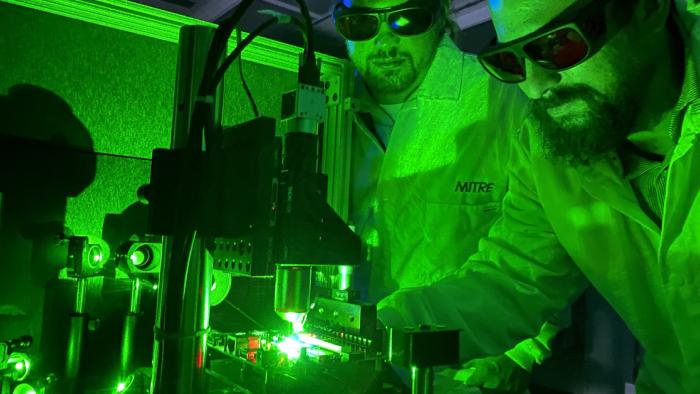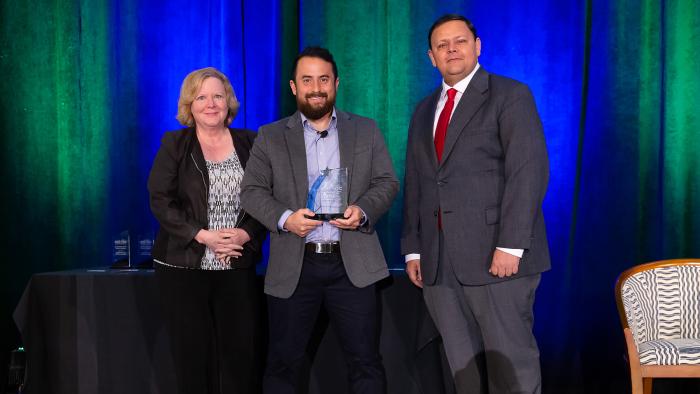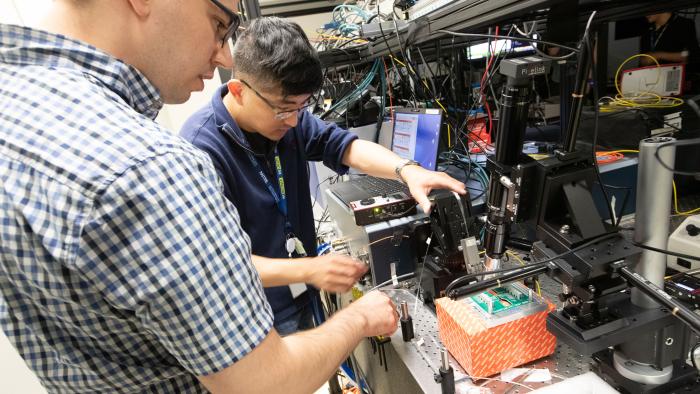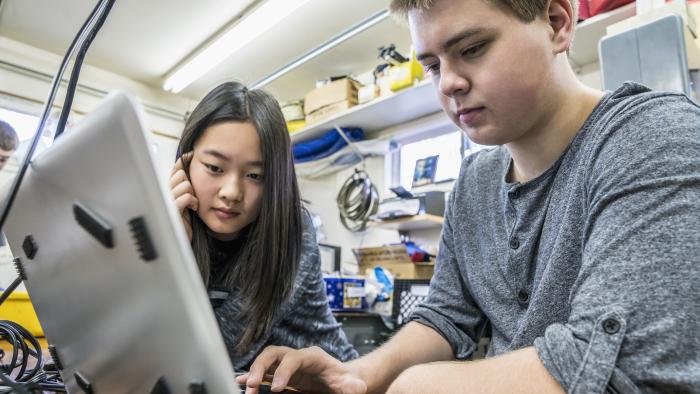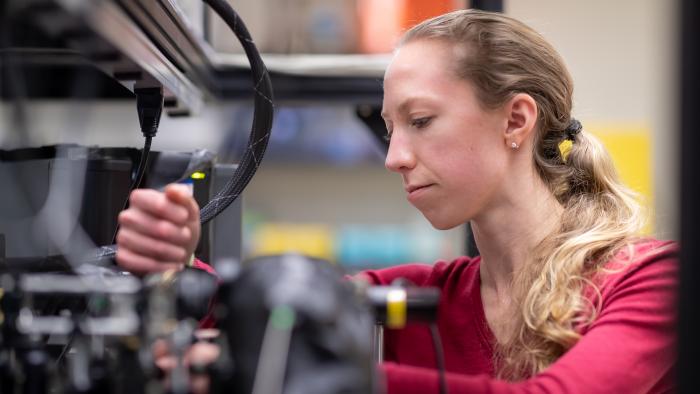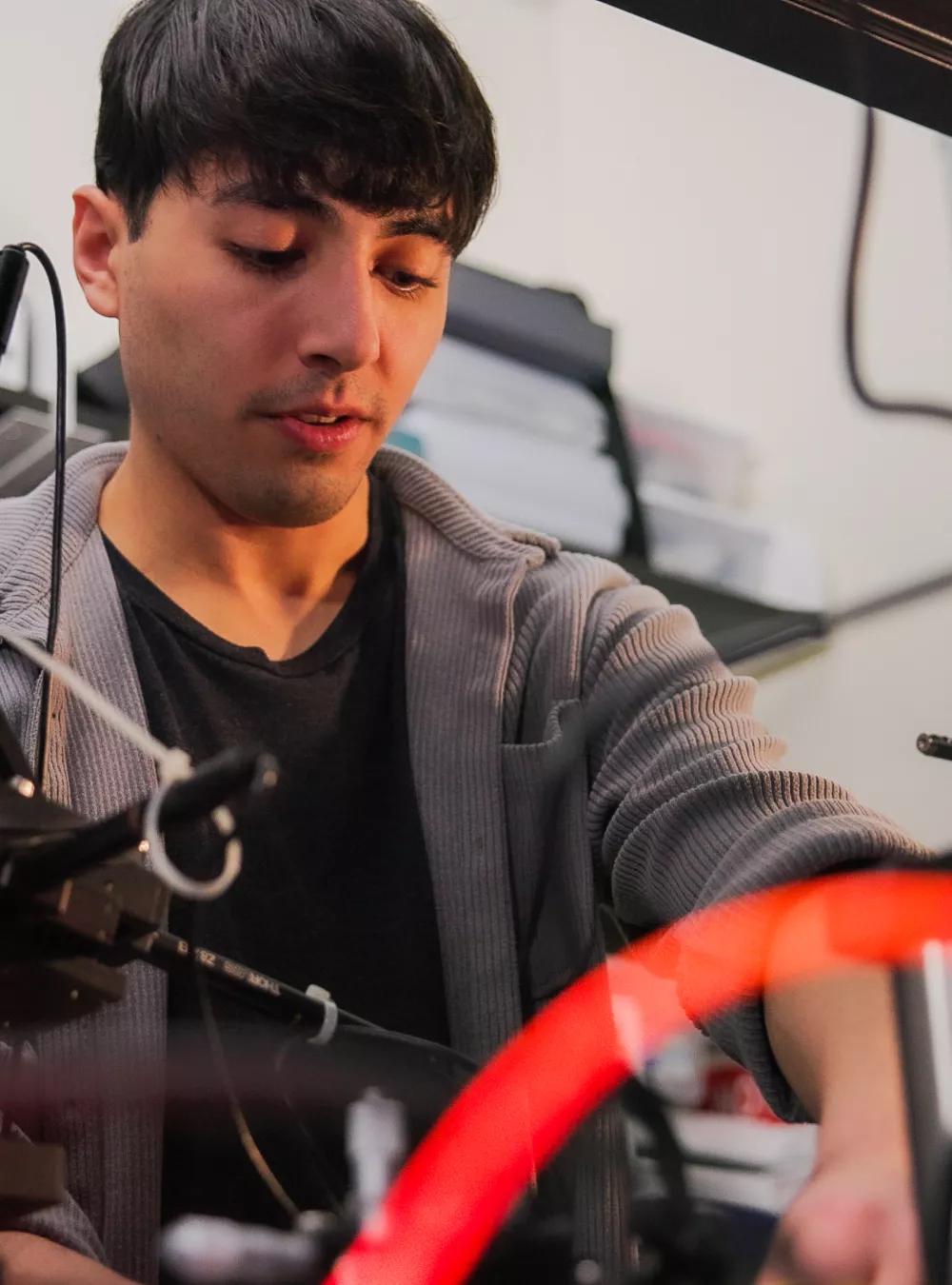
Quantum Moonshot
Solving complex problems with a quantum computer is rapidly moving from science fiction to science reality.
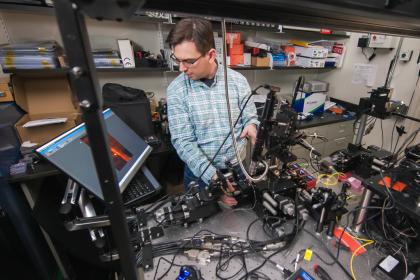
MITRE’s Quantum Moonshot team is building the world’s first fully universal, scalable photonic quantum computer and integrated quantum network.
Led by MITRE Fellow Gerry Gilbert, Ph.D., the team encompasses a diverse set of experts in theoretical and experimental physics, including Dirk Englund, Ph.D., MIT, and Matt Eichenfield, Ph.D., University of Arizona and Sandia National Laboratories. This team has made great progress in four years by combining expertise and resources, including state of the art labs.
Our team is using a hybrid qubit architecture, which combines the unique quantum mechanical properties of light with those of certain charged particles to create quantum bits. In our approach, a qubit is a combination of the quantum mechanical state of an individual photon, a particle of light, and the spin state of an artificial atom within a solid state material defect. (For more details on our technology, see the articles and papers below.)
Why did we choose to work on quantum computers—a quest being pursued by some of the largest companies in the world? Our team brings unique knowledge and resources to the challenge, plus an important mission: solving problems for a safer world. Together, we’re ensuring this game-changing technology aligns with national goals.
Quantum computers, now in their infant stage, will eventually help:
- Advance national security
- Enable fast development of new life-saving drugs, such as vaccines
- Discover new materials
- Make complicated calculations in blinding speed to optimize myriad decisions, from financial investments to where to locate emergency responders
Advancing Quantum Technology
In the last year, our diverse team moved from developing foundational technology to focusing on assembly of an integrated architecture for scalable quantum information processing with hybrid quantum bits. These groundbreaking achievements include:
- Technologies for controlling large numbers of qubits using light and mechanical forces.
- A new type of optical chip for quantum information processing utilizing atom control photonic integrated circuits that can integrate thousands of optical channels for addressing diamond color centers—a leading solid-state qubit.
- Nanoelectromechanical control of qubit frequencies using strain applied by microscopic cantilevers.
- Coherent microwave control of tin-vacancy qubits in diamond with optical initialization, readout and long coherence times. The tin-vacancies’ spin states can encode quantum information.
Although no one can predict the future, we have a strong expectation that we can achieve the goal of a scalable, error-corrected, fault-tolerant quantum computer—contained on a chip.
The Quantum Moonshot Team
Dr. Gerry Gilbert
Dr. Gerald Gilbert, MITRE Fellow, is the principal investigator of MITRE’s Quantum Moonshot Program. A theoretical physicist and quantum information scientist, he is the tenth person to be named a MITRE Fellow since MITRE was founded in 1958. Dr. Gilbert initiated MITRE's Quantum Information Science research program, established MITRE’s site located on the campus of Princeton University and founded the company’s first quantum laboratory there.
Dr. Gilbert also serves on the Board of Advisors of SandboxAQ, an enterprise SaaS company.
Gilbert is a specialist in the study of string theory—an attempt to explain all the fundamental forces of nature, and in quantum information science—the application of the fundamental principles of quantum mechanics to the development of technology to address problems that are otherwise impractical or impossible to solve. He earned his PhD in theoretical physics under the supervision of Nobel Laureate Professor Steven Weinberg at the University of Texas. After earning his Ph.D., Gilbert was awarded the Weingart Prize Research Fellowship in Theoretical Physics at the California Institute of Technology, after which he was awarded a University Research Fellowship at Cambridge University (studying and conducting research under Professor Stephen Hawking) and then worked as a researcher at the University of Maryland at College Park.
Dr. Gilbert has served on the U.S. Defense Science Board and the U.S. Air Force Scientific Advisory Board. He is inventor or co-inventor on multiple U.S. patents in Quantum Information Science and is a sought-after speaker in the field. He received the Best Student Prize and the Patrick M.S. Blackett Award, both from the NATO International School of Subnuclear Physics in Erice, Italy. At MITRE he has received a number of awards, including the Program Innovation Award, MITRE Best Paper Awards, and several Director's Awards for Technical Excellence.
Dr. Matthew Eichenfield
Dr. Eichenfield is an Associate Professor and the SPIE Endowed Chair in the University of Arizona’s College of Optical Sciences, as well as a Distinguished Faculty Joint Appointee at Sandia National Labs. He received his B.S. in physics from the University of Nevada, Las Vegas, and his Ph.D. in physics from the California Institute of Technology, where his thesis on Cavity Optomechanics in Photonic and Phononic Crystals was awarded the best Caltech thesis. After finishing his Ph.D., he became the first Kavli Nanoscience Prize Postdoctoral Fellow at Caltech before joining Sandia as a Harry S. Truman Fellow in 2011.
At Sandia, he founded and led the MEMS-Enabled Quantum Systems group until beginning his joint appointment in 2022. His work spans integrated photonics and phononics in both the classical and quantum regimes.
Dr. Dirk Englund
Dr. Robert Englund is an Associate Professor at the Massachusetts Institute of Technology. He is a faculty member of the Department of Electrical Engineering and Computer Science and a principal investigator in MIT’s Research Laboratory of Electronics and MIT’s Microsystems Technology Laboratory.
Dr. Englund also serves as part-time senior technical staff with the Department of Energy's Brookhaven National Laboratory and he is a scientific member of DARPA’s Microsystems Exploratory Council (MEC).
Dr. Englund received his B.S. in physics from Caltech, winning the D.S. Kothari Prize in Physics for research in quantum optics and biophysics, supervised by Prof. Hideo Mabuchi. Following a year at TU Eindhoven as a Fulbright Fellow (with Prof Bert Koopmans), he began his graduate studies at Stanford University in 2003, earning an M.S. in electrical engineering and a Ph.D. in applied physics (supervisor Prof Jelena Vuckovic). He was a postdoctoral fellow at Harvard University until 2010 (supervisors Prof. Hongkun Park and Prof. Mikhail Lukin), when he joined the faculty of Columbia University as Assistant Professor of Electrical Engineering and of Applied Physics. He joined the MIT faculty in 2013.
Dr. Englund’s research focuses on devices and systems to study, control, and use complex information processing systems: large-scale quantum computing, quantum networks, and machine learning/artificial intelligence accelerators. His research addresses these challenges by a full-stack approach spanning algorithms to large-scale photonic systems, including programmable optics, large-scale control of atoms and spins, to precision measurement and control.
His major awards include: 2011 Presidential Early Career Award for Scientists and Engineers, 2011 Sloan Research Fellowship in Physics, 2012 DARPA Young Faculty Award, 2017 Adolph Lomb Medal, 2018 Bose Research Fellow, 2020 Alexander von Humboldt Foundation Research Fellowship, 2021 Fellow of Optica, 2022 Humboldt Professorship, and Web of Science/Clarivate's "Highly Cited Researcher" (2021: Cross-Field; 2022: Physics).
Dr. Englund has contributed to several disruptive deep-tech companies: Dust Identity, Inc. (co-founder), which focuses on supply chain security and linking unique physical objects to block-chain-secured virtual objects; LightMatter (scientific advisor), which focuses on revolutionizing high-performance computing in machine learning applications; QuEra Computing (co-founder), which is developing the world’s largest quantum simulators and quantum computers; and Quantum Network Technologies (QNT), which focused on building the quantum internet with satellite-assisted quantum repeater links.
About MITRE Moonshots
MITRE Moonshots are high-risk, potentially disruptive research endeavors that require significant investment but can produce significant returns to the nation. Moonshots seek to fundamentally alter the nation’s technical capabilities and approaches to complex problems. We combine diverse expertise, perspectives, and resources by connecting partners in government, industry, academia, and other mission-driven organizations.
